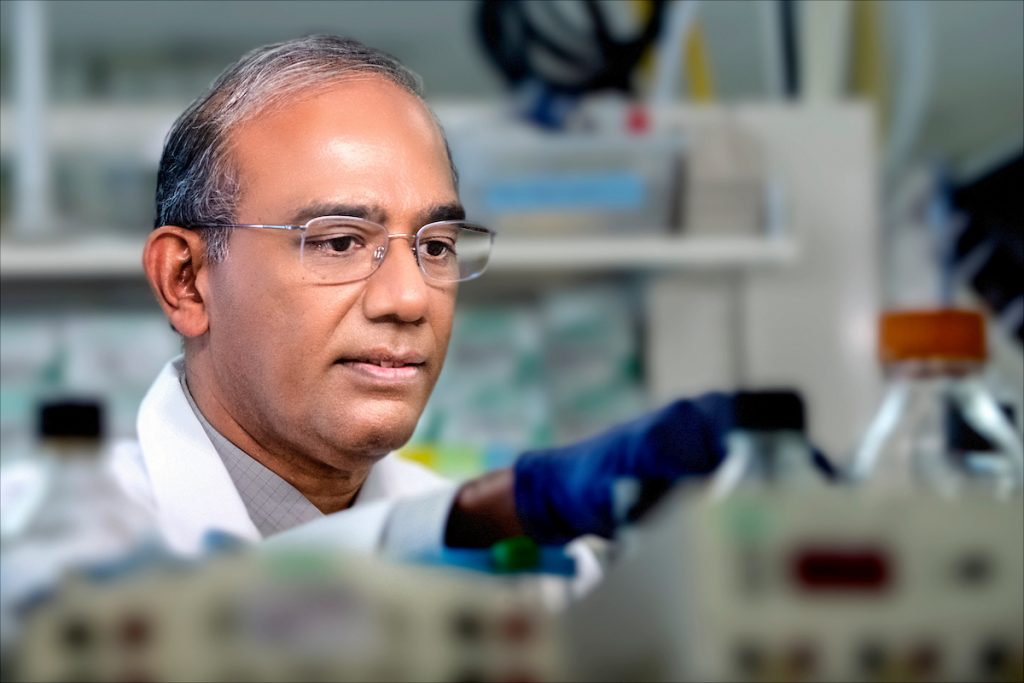
Gopal Thinakaran, PhD, in his research lab at USF Health Byrd Alzheimer’s Center.
More than 6 million Americans live with Alzheimer’s disease, and by 2050, this number is projected to rise to nearly 13 million and cost the nation more than $1 trillion.
Can anything be done to slow, or even stop, this dreaded condition? A group of USF Health researchers is taking a step closer with new research on a critical Alzheimer’s risk factor. Their work has been published by a major peer-reviewed science journal, Molecular Neurodegeneration.
The paper’s authors are part of the Thinakaran Lab, at USF Health’s Byrd Alzheimer and Research Institute. They are investigating mechanisms that may exacerbate the onset of Alzheimer’s, specifically a protein called Bridging Integrator 1, or BIN1, a critical component of inflammation. Understanding BIN1 has been a challenge because it appears in different forms.
“Brain inflammation is a big problem,’’ said Gopal Thinakaran, PhD, CEO of the Byrd Center and professor of molecular medicine at the USF Health Morsani College of Medicine. “While studying its role in different brain cells, we suspected that BIN1 might have an essential function in the brain’s immune cells, called microglia. How it influences Alzheimer’s is a fine point … it’s an important piece of the puzzle.’’
The USF Health team said BIN1 is a significant genetic risk factor for late-onset Alzheimer’s disease. BIN1 is known to regulate membrane dynamics in a range of crucial cellular processes. Although the expression of BIN1 in the brain has been characterized in detail, information regarding microglial BIN1 expression is limited. Until now, BIN1 protein expression and its role in microglia, a cell type most relevant to Alzheimer’s disease, have not been examined in depth.
The research article is titled “BIN1 is a key regulator of proinflammatory and neurodegeneration‑related activation in microglia.’’ The work is the product of a fruitful collaboration between the Thinakaran Lab at USF and the Rangaraju Lab at University of Emory. Its USF authors include Ari Sudwarts, Moorthi Ponnusamy, Shuai Wang, Mitchell Hansen, David Beaulieu‑Abdelahad, Xiaolin Zhang, Lisa Collier, Charles Szekeres, and Dr. Thinakaran.
Microglia monitor for unusual molecules in the brain generated during infection or neuronal damage. Upon detection of any hazard, microglial shape and activity get transformed from a “surveillance” to an “activated” mode, as they become competent to dispose of dead or damaged cells and unwanted proteins that clutter the brain. This brain immune response is the primary task of microglia.
Until recently, brain inflammation and the immune response of microglia were believed to be secondary to the death of neurons, which kick-start Alzheimer’s. However, studies have established that some genes specific to microglia pose the highest risk for developing Alzheimer’s disease by interfering with microglia’s activities. The USF study shows that BIN1’s involvement in disease risk may also center around its role in supporting microglial health and the brain’s immune responses.
The main message from this study is that by regulating the brain’s immune responses, BIN1 may play a crucial role in promoting microglial cell progression from the surveillance to activated microglia. In its study, the team used laboratory stains in mice. Without BIN1, microglia could not mount an appropriate response to the inflammatory challenge and remained closer to a “resting’’ state. “This means that the BIN1 function is vital for microglia to conduct surveillance in the brain for problems and be poised to mount an effective inflammatory response to tissue damage or noxious stimuli generated during brain diseases,’’ the report states.
The team is continuing its research to ask whether BIN1 may act as a risk factor for Alzheimer’s disease by changing “normal’’ brain inflammation to uncontrolled activation often found under pathological conditions.
Alzheimer’s is a specific brain disease that progressively and irreversibly destroys memory and thinking skills. Age is the biggest risk factor for the disease. Eventually, Alzheimer’s disease takes away the ability to carry out even the simplest tasks, according to the Alzheimer’s Association, a global voluntary health organization dedicated to Alzheimer’s care, support and research.
The vast majority of people who develop Alzheimer’s dementia are age 65 or older. Experts believe this late-onset Alzheimer’s, like other common chronic diseases, develops as a result of multiple factors rather than a single cause. Exceptions are cases of Alzheimer’s related to uncommon genetic changes that greatly increase risk.
However, the relatively recent discovery that Alzheimer’s begins 20 years or more before the onset of symptoms helps explain why it has been difficult to prevent and treat Alzheimer’s effectively, the association said.
Story by Kurt Loft.
